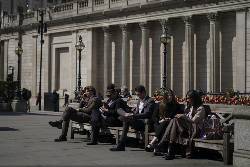LONDON (AP) — The Bank of England cut its main interest rate by a quarter of a percentage point to 4.25% amid concerns over the potential shock to global growth emanating from the tariff policies of the Trump administration.
The decision Thursday was widely expected, though there was an array of opinion on the nine-member Monetary Policy Committee, with two voting for a bigger half-point cut to 4%, and two voting to hold rates.
Bank Gov. Andrew Bailey said inflationary pressures have continued to ease, paving the way for the rate cut.
“The past few weeks have shown how unpredictable the global economy can be,” he said. "That’s why we need to stick to a gradual and careful approach to further rate cuts. Ensuring low and stable inflation is our top priority.”
The decision comes ahead of a trade deal between the U.S. and the U.K., which will likely lower the burden of President Donald Trump’s sweeping tariffs.
Trump posted on his Truth Social platform that a deal due to be announced at 10 a.m. EDT (1400 GMT) will be a “full and comprehensive one that will cement the relationship between the United States and the United Kingdom for many years to come.”
The imposition of U.S. tariffs on British goods, and the potential for a U.S.-China trade war in particular, has the potential to weigh on global growth.
Though most tariffs were paused for 90 days following the ensuing market turmoil, including the 10% baseline tariff applied to U.K. goods entering the U.S., the backdrop for the global economy remains highly uncertain.
The imposition of U.S. tariffs on British goods, and the potential for a U.S.-China trade war in particular, has the potential to weigh on growth as well as oil prices, which would consequently depress price pressures by lowering demand.
Though U.K inflation stands at 2.6% and could well hit double the bank’s target rate of 2% in coming months as a result of a raft of price increases in April, such as domestic energy and water bills, economists think rate-setters will opt for a cut, given the anticipated slowdown.
Unlike the Bank of England, and the European Central Bank, which last month cut interest rates too, the U.S. Federal Reserve kept rates unchanged Wednesday as its policymakers wait to see how Trump’s tariffs affect the U.S. economy before making any moves.
Inflation rates around the world are way down from levels seen a couple of years ago, partly because central banks dramatically increased borrowing costs from the near zero rates during the coronavirus pandemic. Prices then began to shoot up, first as a result of supply chain issues and later because of Russia’s full-scale invasion of Ukraine, which pushed energy costs higher.
As inflation rates have declined from multidecade highs, central banks, including the Fed, have started cutting interest rates, though few, if any, economists think that rates will fall back to the super-low levels that persisted in the years after the global financial crisis of 2008-2009 and during the pandemic.
...


 Copyright © 1996 - 2025 CoreComm Internet Services, Inc. All Rights Reserved. | View our
Copyright © 1996 - 2025 CoreComm Internet Services, Inc. All Rights Reserved. | View our